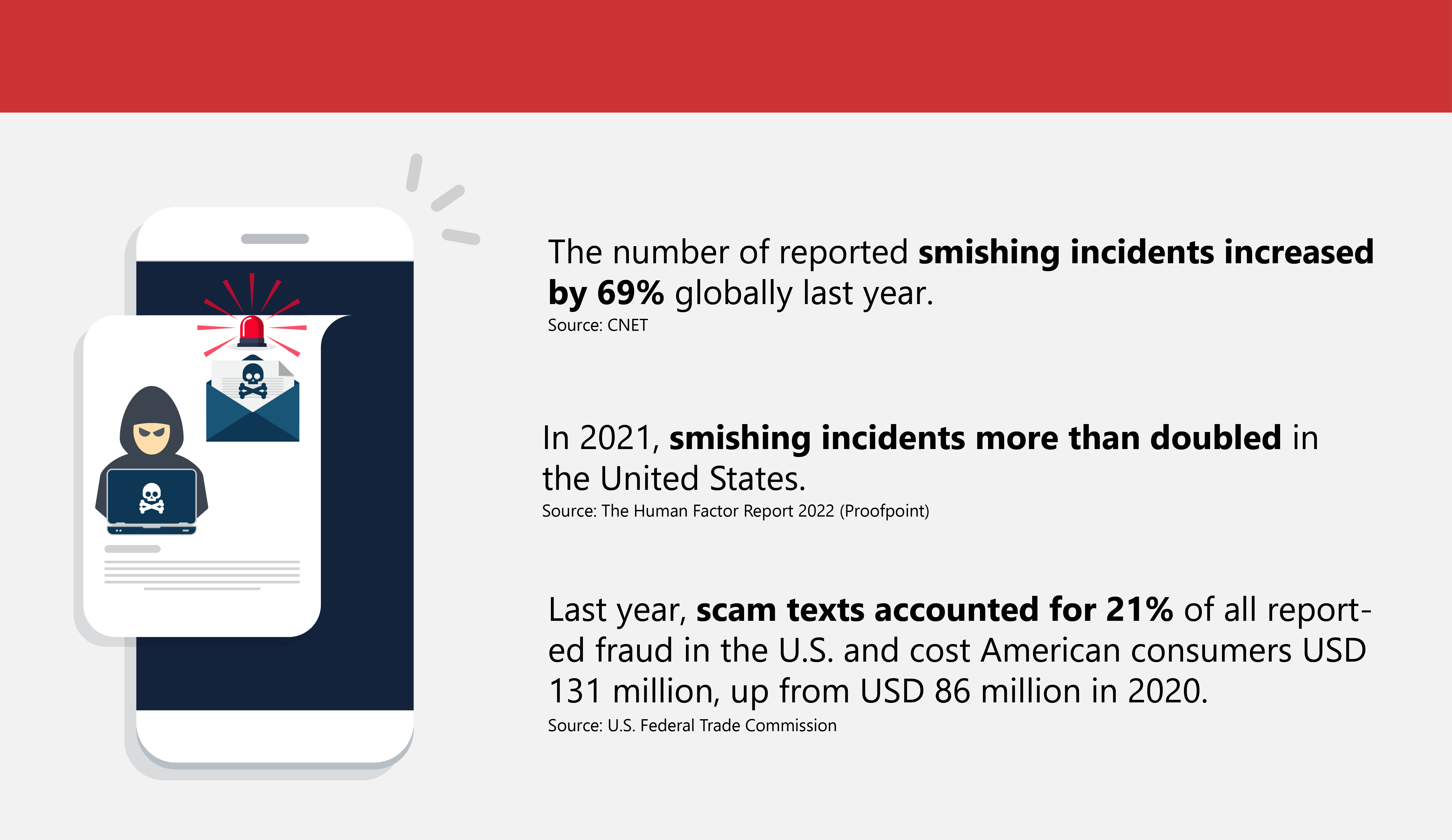The Rise of Text Scams Be Smart About Your Smartphone

Scammers are everywhere—and they really want to exchange text messages with you on your smartphone.
And who can blame them? Thanks to apps and the Internet, we do everything on our smartphones: shop and socialize, pay bills and do banking. There are 6.64 billion smartphone users globally—fertile ground for text scams that could lead to identity theft and financial ruin. In this article, we talk about common text scams and how to avoid them.
Smishing
Text scams have become so common that it has a name: smishing. The term combines SMS, or “short message service,” with phishing. Phishing is another type of online fraud where scammers contact you via email instead of text messages.
With smishing, cybercriminals text you a message to trick you into revealing private data, such as your account number or password, clicking a link to a fake website that steals your financial information, or downloading malicious programs to your smartphone.
Just how prevalent are text scams? Let’s look at the numbers.

(Also read: Why Digital Security Is a Big Deal)
Mind games to reel you in
With scam texts, cybercriminals turn psychological triggers into powerful weapons.
To get you to answer their texts, they entice you with a prize, like gift cards, a new laptop, or a free vacation to a tropical island. To claim the prize, you have to give them your personal and banking information or pay a fee.
They alarm you with a serious problem that needs your urgent attention: suspicious activity on your credit card, a locked bank account, a missed package delivery, or an issue with your social security benefits. To fix the issue, they’ll need your account information or send you a website link with further instructions.
They misdirect you by pretending to text the wrong number to get you to reply. The text message could be about a doctor’s appointment, a question about a sick pet, a missed romantic connection, or a problem at the office. The text looks like it was for someone else, but you don’t want that person to miss an important message, so you reply that they’ve got the wrong number. The scammer apologizes for the mistake, thanks you for giving them a heads up, and starts talking to you about something else instead.
And because you don’t want to miss out on a “prize,” are worried the “problem” will get worse, or would like to help someone with their “mistake,” there’s a big chance you will answer the scammer’s message—especially if it’s via text.
“SMS phishing—or ‘smishing’—lures typically prey on our bias towards urgency and loss aversion,” says enterprise security company Proofpoint in their recent The Human Factor Report. “These psychological triggers are especially powerful in the context of phones, as we tend to be much more responsive to mobile messages than to email or computer messaging.”
The scammer’s objective is your engagement. As long as they can keep you in the conversation, they can steer you toward what they really want.
Typically, text scammers are trying to make you do any of these three things:
- Click on a link that downloads malware onto your smartphone. Once your device is infected, cybercriminals can steal sensitive information, spy on you, or lock you out of your smartphone and demand a ransom.
- Direct you to a fake website that steals your personal information, such as passwords, credit card or bank account numbers, and your credentials.
- Send them payments or investments through cryptocurrencies or digital wallets.
(Also read: How to Protect Yourself from the Rise of Ransomware)
Staying safe from text scams
Here are some tips to avoid falling prey to cybercriminals and their text scams:
- If you receive a suspicious text, don’t reply to it—even if the message asks you to text “STOP” to stop receiving messages.
- Never click on any links from unsolicited text messages. These links can infect your phone with malware or send you to fake websites that steal financial and personal information.
- Never provide sensitive financial and personal information via text.
- If you’re not sure if the message is legitimate, contact the government agency or company directly using a website or phone number that you’re 100% sure is real and not the information in the text message.
- Update your operating system software and security apps regularly. When downloading applications or any other software, only do so from trusted platforms.
- Check your bank and credit card statements regularly. Keep an eye out for charges that you don’t recognize.
(Also read: How to Protect Yourself from Online Fraud)
Keep scammers out of your smartphone by filtering unsolicited messages or blocking them altogether. If you’re using an iPhone, here’s how to filter and block messages, filter messages from unknown senders, and report spam or junk messages. Follow these steps to filter, block, and report spam texts on an Android phone.
Avoid becoming a victim of smishing by slowing down and staying sharp. Don’t respond to suspicious texts, refrain from clicking on suspicious links, and never divulge personal, sensitive, or financial information to strangers lurking on your smartphone. It is the Swiss Army knife of tech gadgets: our sidekick for work and play, our health and money, our hobbies and interests. Let’s be smart when using it.
As one of the Top 19 EMS companies in the world, IMI has over 40 years of experience in providing electronics manufacturing and technology solutions.
We are ready to support your business on a global scale.
Our proven technical expertise, worldwide reach, and vast experience in high-growth and emerging markets make us the ideal global manufacturing solutions partner.
Let's work together to build our future today.
Other Blog


